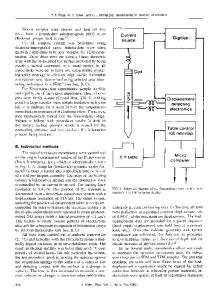Stress distribution in particulate-reinforced metal-matrix composites subjected to external load
- PDF / 5,013,490 Bytes
- 11 Pages / 597 x 774 pts Page_size
- 70 Downloads / 272 Views
I.
INTRODUCTION
IN recent years, interest in discontinuous fiber metal matrix composites (MMCs) has been rapidly increasing. This is because (a) these types of MMCs can now be produced more economically through even conventional metallurgical techniques, such as direct casting, (b) they can be macroscopically isotropic in mechanical properties, and (c) often they can be shaped by forging or extruding. Unlike in the continuous fiber-reinforced MMCs, where the continuous fibers are the load carrier and the metal matrix is only the load transferrer, in discontinuous fiber-reinforced MMCs, both the reinforcement (whiskers or particulates) and the metal matrix are the load carrier. Therefore, deformation and strengthening mechanisms in these types of MMCs are different from that in the continuous fiber MMCs and, in fact, the metal matrix in discontinuous reinforcement MMCs has already been found to play important roles in the deformation process. Arsenault and Fisher rlj in 1983 proposed that the increased strength observed in SiC (short fiber)/ A1 composites could be accounted for by a high dislocation density in the aluminum matrix. This idea was later supported by a number of experimental results. Typically, Vogelsang et al. ,121using an in situ high-voltage electron transmission microscope, showed that a very high dislocation density appeared in the A1 matrix upon cooling the SiC (short fiber)/A1 composite from 773 to 300 K. These dislocations were produced by thermal stresses resulting from the large difference in the coefficient of thermal expansion (CTE) between SiC and A1. Taya and Mori 131used the Eshelby approach to study this mechanism of dislocation generation by the so-called dislocation punching effect due to the CTE difference in ZHIRUI WANG, Assistant Professor, is with the Department of Metallurgy and Materials Science, University of Toronto, Toronto, ON M5S 1A4, Canada. TZI-KANG CHEN, Research Engineer, is with the United States Army Materials Technology Laboratory, Watertown, MA 02172. D.J. LLOYD, Principal Research Scientist, is with the Kingston Research Centre, ALCAN International Ltd., Kingston, ON K7L 5L9, Canada. Manuscript submitted November 15, 1991. METALLURGICAL TRANSACTIONS A
a short fiber MMC and found that the larger the values of supercooling and dislocation-friction-stress/shearmodulus ratio, the larger the punching distance becomes, but the latter decreases with the fiber aspect ratio. The influence of CTE misfit on the strength of particulate composites has recently been considered in some detail by Arsenault and Shi, f41 Christian and Suresh, tS] and Taya et al. t6l These studies suggest that the dislocation density generated to accommodate the CTE misfit can provide a significant strengthening component to the composite. In addition to the works cited above, numerous reports can be found in recent years discussing the relationship between the change of dislocation density due to ceramics/metal CTE difference and the strengthening phenomenon for other systems of M M C s . 17-141 A
Data Loading...











